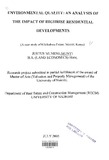| dc.description.abstract | Increasing the densities of existing residential areas is often seen as a convenient option to address the problem of housing shortage in many urban centres. This is mainly due to the fact that existing neighbourhoods are fully serviced and the basic infrastructure is in place, hence eliminating the cost of providing the same.
However, the densification process, and especially in previously high income estates, such as Kileleshwa have had adverse environmental impacts which the planners never envisaged or ignored altogether, as they tried to take advantage of existing infrastructure and services.
An ideal residential estate must meet multiple goals, which include healthy living i.e. devoid of pollution, for its habitants, well planned as to afford constant water supply, efficient sewer and garbage disposal systems, well paved/tarmac roads, free from traffic congestion and availability of social centers/open spaces.
The objectives of this study is to establish the various key environmental impacts linked directly to construction of multi-storey buildings; to identify | |

